The Ukulele: A History More Than a Tiny Guitar
Ukulele History:
Although the ukulele may appear to be a small guitar, its spiritual history is intricate and constantly changing. People throughout the world have been moved by this joyful four-stringed instrument, which has been embraced by various musical traditions and traveled across oceans. It is clear from looking at the priceless Ukulele history why this little instrument has had such a significant impact.
From Portuguese Roots to Hawaiian Shores of Ukulele History
The ukulele actually originated in Portugal in the 19th century, not Hawaii. Portuguese colonists introduced the machete, braguinha, and cavaquinho—small, guitar-like instruments—to Hawaii in 1879. The body and soundboard of these instruments, especially the machete, were comparable in size and shape to the soon-to-be-developed ukulele.
Portuguese woodworkers Manuel Nunes and Augusto Dias began modifying the designs when they first arrived in Honolulu, using the indigenous koa wood instead of the lighter, brighter-sounding strung version.
Hawaiians quickly adapted to the instrument. The word “ukulele” means “jumping flea,” presumably alluding to the way the players’ fingertips seem to leap around the strings. Hawaii’s final ruler, King Kalākaua, supported the ukulele, incorporating it into royal events and hula performances and establishing it as a royal palace instrument.
The Ukulele Goes Global
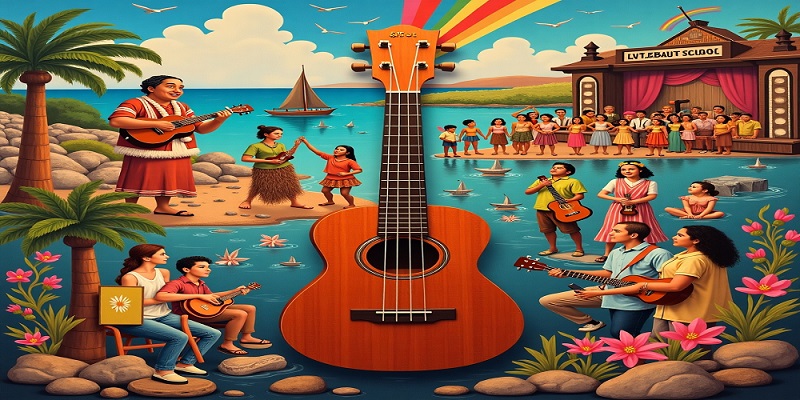
Outside of Hawaii, the ukulele began to gain popularity in the early 1900s. The instrument, which responds to hula tänze with ukulele in tandem, was first shown to the public at the Panama-Pacific Exposition in San Francisco in 1915. The ukulele became a staple of early American pop music thanks to vaudeville performers such as Cliff “Ukulele Ike” Edwards; by the 1920s, it was a popular instrument in homes. It was inexpensive, upbeat, and especially well-liked during the Great Depression since it provided a musical diversion during difficult times.
Decline and Revival
During the 1950s and 1960s, when rock ‘n’ roll was in vogue and electric guitars overpowered the ukulele’s subdued sound, its popularity plummeted. Prior to a significant resurgence in the 1990s, it was regarded as a novelty instrument for many years. Israel Kamakawiwoʻole, a Hawaiian musician, introduced the ukulele to a new generation with his melancholic performance of “Somewhere Over the Rainbow.” Artists like Jake Shimabukuro demonstrated its versatility through viral performances, and social media and YouTube contributed to its resurgence.
The Ukulele Today vs Ukulele History
The popularity of the ukulele has never been higher than it is now. Pop artists like Taylor Swift and Billie Eilish have used it in their songs, and because of its small size and ease of use, schools all over the world use it to teach beginning musicians. Custom ukes made by luthiers and builders contain some of the same premium components found in great guitars.
Why Its History Matters
The ukulele has been played by Portuguese sailors, Hawaiian royalty, and people from all over the world, from theatre stages to viral videos. The idea that music transcends all limitations and that something so small can produce a cacophony that will reverberate for all eternity still gives perspective. Understanding its background enhances the enjoyment of each chord, whether you’re a player or just a spectator.
And the journey of the ukulele doesn’t end there. One thing will remain constant as it expands: the ukulele is more than just an instrument; it’s a worldwide phenomenon.
1. The Ancestors of the Ukulele: Portuguese Origins in Ukulele History
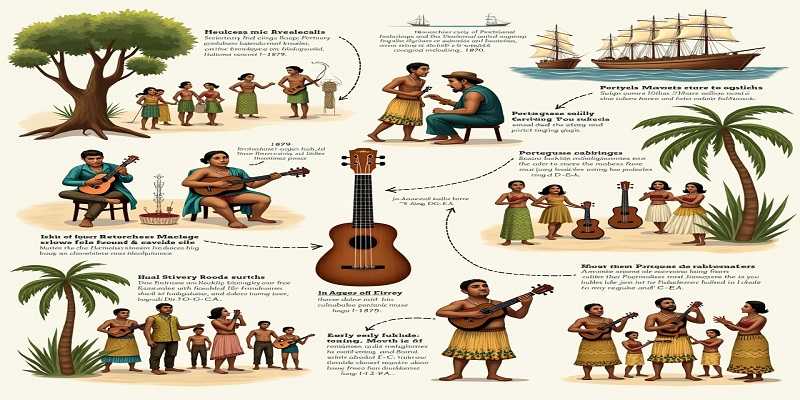
The ukulele was not created in Hawaii despite being so strongly associated with that culture. Its shape was influenced by early little instruments that resembled guitars in Portugal, which is where it actually originated. To comprehend how the ukulele became the well-liked instrument it is now, it is crucial to be aware of its past.
1.1 The Machete de Braga: A Miniatury Marvel
In Madeira and the Açores, the ukulele is said to have been invented by a machete de Braga, or machete, which was imported from Braga, Portugal, in the middle of the nineteenth century. During the 19th century, folk performers preferred this little, four-stringed instrument, which is frequently made from native woods like mahogany or citrous family members.
- Dimensions and Tuning: The machete was a little smaller than the contemporary soprano ukulele and was typically tuned to D-G-B-D, which is a re-entrant tuning similar to the high-G tuning of the ukulele.
- Construction: Like early ukuleles, early models had a teardrop body, gut strings, and friction-tuning pegs.
- Musical Function: It performed rounded dances and classic fado tunes, referring to the greasy, rhythmic sound of the ukulele.
The Portuguese ancestor of the ukulele, which immigrants brought to Hawaii, might not have existed if it weren’t for that machete.
1.2 The Braguinha & Cavaquinho: Ukulele Relatives
Two additional Portuguese instruments inspired the Ukulele History:
Braguinha
- A machete, sometimes with a deeper-register sound, that is “ever so slightly bigger” (his).
- It was one of the guitars brought to Hawaii in the late 1800s after being played on the island of Madeira.
Cavaquinho
- The cavaco is a four-stringed instrument that is also well-liked in Portugal and Brazil.
- Its altered tuning (D-G-B-D or G-C-E-A in some areas) influenced Caribbean and Brazilian samba music.These belonged to a series of compact, portable chordophones that immigrants and sailors carried over the globe. Portuguese laborers carried their musical traditions and instruments with them when they arrived in Hawaii.
These chordophones were small and easy to carry. Sailors and refugees from all over the world brought them there. Portuguese laborers carried their musical traditions and instruments with them when they arrived in Hawaii.
1.3 The Trip to Hawaii: Arriving and Settling In
In 1879, Portuguese laborers recruited from Madeira arrived in Honolulu aboard the Ravenscrag. Among them were three cabinet craftsmen who would go on to have a significant impact on ukulele history:
a. Manuel Nunes
b. Augusto Dias
c. José do Espírito Santo
Using koa wood, which produced a richer and fuller tone than gut strings, these craftspeople started creating instruments that resembled machetes and tailored them to Hawaiian tastes.
João Fernandes: The First Player
João Fernandes, one of its immigrants, was a gifted musician who began playing his braguinha as soon as he stepped onto the docks. His lightning-fast fingerwork captivated Hawaiians, who started referring to the instrument as the “ukulele” or “jumping flea” due to the way his fingers flashed back and forth.
The Transformation of the Instrument in Hawaii
a. Local Materials: Hawaiian koa and acacia wood were used in place of European spruce and mahogany.
b. New Tuning: The Portuguese and Hawaiians utilize G-C-E-A tuning, which has become the norm today.
c. Artistic assimilation: the Hawaiian musical culture quickly adopted the instrument, particularly in hula.
2. The Birth of the Ukulele: Hawaiian Innovation
The ukulele may have the most fascinating history of cross-cultural interaction, unadulterated craftsmanship, and royal support of any Hawaiian instrument. It developed as an art form in the late 19th century as a result of the blending of Hawaiian craftsmanship with Portuguese immigrant customs.
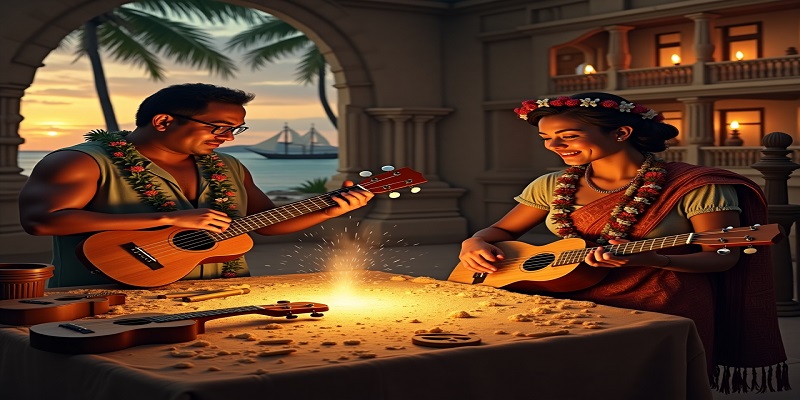
2.1 What’s in a Name: Ukulele Myths and Realities in Ukulele History
One of the most enduring myths about the ukulele is that it is a Hawaiian name for “jumping flea.” It has been hypothesized that skilled players’ rapid finger movements resembled hopping fleas. Experts in the Hawaiian language, however, have different theories. “The ” gift that came here” is a reference to the Portuguese immigrants who brought the small guitar to the islands. According to some, the term “ukelele” is a mix of the Hawaiian terms “uku” (gift or reward) and “lele” (to come). Uku is interpreted as a gift, prize, and lele as to go in another derivation that has a more positive tone towards the instrument.
English speakers may have embraced the “jumping flea” version of the narrative, but linguistic and historical evidence points to a deeper, more lyrical meaning that connects the story to Hawaiian culture.
2.2. The First Ukulele Makers: Nunes, Dias and Santo in Ukulele History
Portuguese instruments like the machete and braguinha, which were introduced to Hawaii by immigrants in the 1870s, are the ancestors of the ukulele. These instruments eventually evolved into what is now known as the modern ukulele, and Manuel Nunes, Augusto Dias, and José do Espírito Santo are the three persons most closely linked to its creation.
The warm, resonant tone of the ukulele was produced by craftsman Manuel Nunes, who created the Portuguese designs using Hawaiian woods like koa. José do Espírito Santo and Augusto Dias also contributed to the instrument’s development by experimenting with various body shapes, tunings, and string materials.
The little four-stringed instrument was already uniquely Hawaiian, thanks to their inventions. The ukulele gained popularity when its construction shifted from European-style to more Hawaiian-looking elements, such as lighter and more portable designs and the usage of koa wood.
2.3 King Kalākaua, The Ukulele’s Royal Patron in Ukulele History
The ukulele as a symbol of culture The impact of the popularity of the ukulele on King David Kalākaua Known as the “Merrie Monarch,” King David Kalākaua played a significant role in the development of the ukulele. Kalākaua was a music and dance enthusiast who brought the ukulele to public concerts, hula dances, and royal events.
Symbol of Hawaiian Identity: The ukulele became a national symbol because of Kalākaua’s sponsorship of the arts in Hawaii during a time when Western culture challenged traditional customs.
A key component of the sound of traditional hula and mele (chants) was the ukulele’s bright, percussion-like sound.
On Liliʻuokalani’s bed lies a ukulele that she used during one of her performances during the American annexation of Hawaii. From an immigrant workshop to the beach and one of the most important emblems of Hawaiian culture, the ukulele was transported across the Pacific and expanded under Kalākaua’s patronage. The drink’s globalization was aided by its association with happiness, hospitality, and the attitude of aloha.
3. Bringing the Ukulele to the World (Early 20th Century)
(The ukulele had previously gained popularity in the early 1900s and was a standard instrument in Hawaiian music, but its rise to international prominence mostly started in America.) The 1915 Panama-Pacific Exposition and its adoption by Tin Pan Alley composers and vaudeville performers were two critical causes in its development.
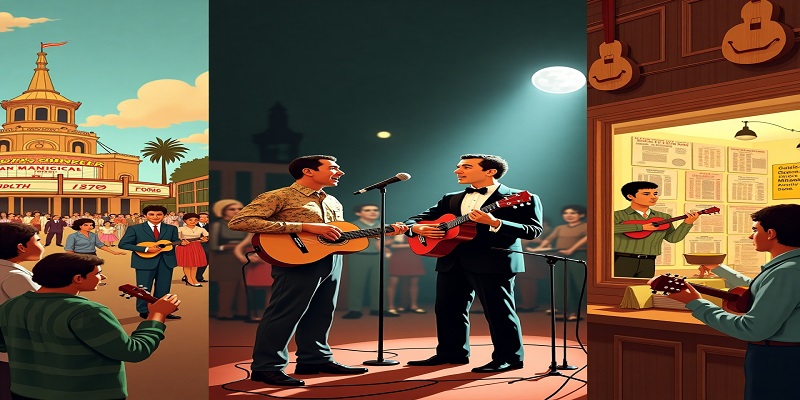
3.1 The 1915 Panama-Pacific Exposition: “A Cornerstone”
In 1915, the Panama-Pacific International Exposition was held in San Francisco as a world’s fair to celebrate the Panama Canal’s completion. At the time, Hawaii, a U.S. territory, had its pavilion where performers like Ernest Ka’ai, Johnny Noble, and the Hawaiian Quintette performed both contemporary and traditional Hawaiian tunes, with the ukulele taking center stage.
American viewers are enamored! A nationwide “Hawaiian Craze” began when Americans fell in love with the ukulele’s lovely, joyful melodies during the fair.
Hawaiian Music in Jazz and Pop: Hawaiian music, which influenced and clashed with early jazz and ragtime, was first heard by mainland audiences at the Panama Pacific Exposition. Hits like “On the Beach at Waikiki” (1915) helped the steel guitar, another Hawaiian product, gain prominence alongside its ukulele relative.
3.2 Vaudeville & Tin Pan Alley Pop Music
Following the fair, the ukulele was a popular instrument in Tin Pan Alley, the hub of the popular music scene in America, and vaudeville theaters.
Cliff “Ukulele Ike” Edwards’ Legacy
Cliff “Ukulele Ike” Edwards, a vaudeville performer who later became a radio celebrity and the voice of Disney’s Jiminy Cricket, was one of the most well-known early ukulele performers.
His quick strumming and inventive singing made the ukulele a standard instrument among performers in the 1920s.
Well-known songs such as “Singin’ in the Rain” (1929, but performed two years earlier) showed that the ukulele could be utilized for both jazz and pop.
Sales of Sheet Music and the Ukulele Boom of the 1920s
Because of its ease of use, the ukulele was perfect for beginners, and Tin Pan Alley joined the trend by selling millions of ukulele teaching books and sheet music.
Among the songs that became ukulele standards were “Ain’t She Sweet” and “Five Foot Two, Eyes of Blue.”
Ukuleles became a standard home instrument once companies like Martin Guitars began selling them by the ream.
The ukulele, which appeared in dance halls, theaters, and living rooms all over America by the late 1920s, came to symbolize the Roaring Twenties. It was joyful and carefree like the times, and it earned its place in the annals of pop music.
4. The Golden Age (1920s–1940s) in Ukulele History
Between the 1920s and 1940s, the ukulele was a popular cultural and media symbol of joy during the Roaring Twenties, a source of personal comfort as the Great Depression grew more dire, and an amateur musical instrument used to console and uplift soldiers during World War II. Its energetic sound, small size, and relative affordability made it ideal for a time when social change was happening quickly.
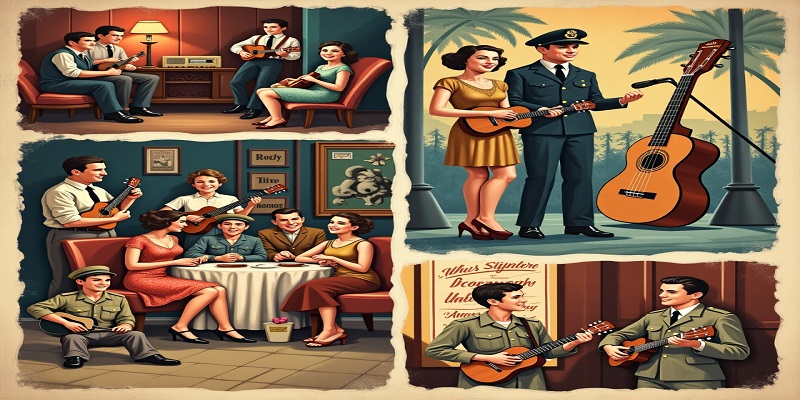
Read More about : A History of royal scorchios
4.1 The Roaring Twenties: A Sign of Happiness
The ukulele was a perfect fit for the decade’s jazz, frivolous amusement, and rebellion.
Prohibition and Speakeasies: During Prohibition (1920–1933), speakeasies served live music and were effectively illegal bars. Performers who played ragtime, jazz, and novelty songs were drawn to the ukulele’s mobility and upbeat tone.
Jazz and Blues Iconography Learn to Play the Ukulele: Although the ukulele was once considered a comedy instrument, it has also been adopted by professional performers.
Louis Armstrong used a ukulele in his recordings and performances, introducing it into early jazz.
Sometimes, it was used for intimate, rhythmic accompaniments by blues singers like Bessie Smith.
Roy Smeck, who gained notoriety as the “Wizard of the Strings,” enchanted audiences with his powerful ukulele solos during vaudeville shows.
A symbol of the free-spirited energy of the day, the ukulele could be heard on the radio, in movies, and in the hands of college students and flappers.
4.2 The Great Depression & World War II: A Portable Getaway
The 1929 stock market crash and the ensuing Great Depression marked the end of the carefree Jazz Age, but the ukulele obsession persisted.
A Depression-Era Comfort on a Budget: The ukulele was still reasonably priced, with some versions starting at only $5, even though many people were struggling financially.
In order to find comfort and relief from adversity, families and friends gathered to sing and play.
Sing-along radio shows feature ukuleles to encourage at-home singing.
World War II: The Sidekick of a Soldier:
Because of its compact size, GIs could easily carry it in their field packs and use it as entertainment during prolonged deployments.
Ukulele music was commonly used in USO concerts and war movies (with Betty Grable or Bing Crosby) to express the dedication to the cause.
To provide for the military and civilians, companies like Harmony and Regal manufactured strong, affordable ukuleles in large quantities.
By the 1940s, the ukulele had moved past being a passing trend and had become a cultural mainstay, loved by Hollywood celebrities, soldiers, and regular people who needed a little cheer during difficult times.
5. The Decline (1950s–1980s): From Fame to Obscurity
By the mid-1900s, the ukulele’s heyday had come to an end. It was once a favorite among young people in America, but it has gradually lost ground to new musical interests and changing cultural preferences. However, despite its demise, the ukulele managed to keep its specialized following and experience a sporadic resurgence.
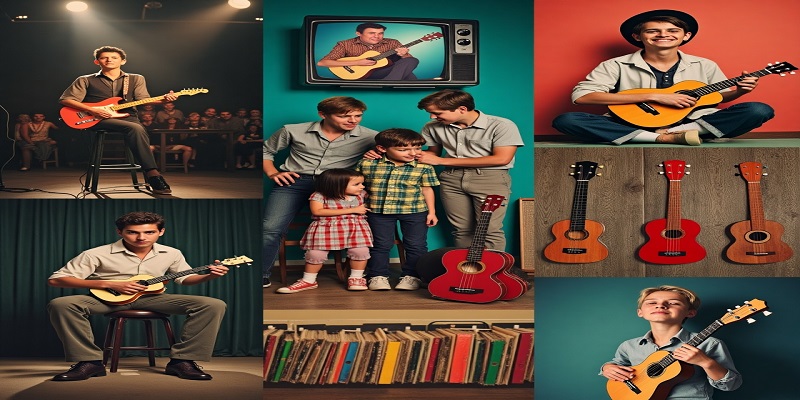
5. 1 : Rock ‘n’ Roll Greets The Ongoing Fade Out Of The Ukulele
The 1960s and late 1950s brought a massive rupturing of taste in popular music, and, for the ukulele, it was like trying to follow Hendrix on acoustic guitar.
Electric Guitars Take the Lead:
The raw power of rock ‘n’ roll, spearheaded by acts like Elvis Presley, Chuck Berry, and The Beatles, rendered the ukulele a trifle by comparison.
Electric instruments came into play, and there was no way the soft, acoustic sounds of the ukulele could compete with the wailing of the electric guitar.
The Stigma of “Novelty”:
Where it had once been respectable, the ukulele became more and more a toy — for kids and comedians.
And that it was linked to corny TV variety shows and tourist souvenir shops only deepened its bad reputation within the ranks of serious musicians.
In the 1960s, the ukulele had all but disappeared from popular music, surfacing mainly in Hawaiian tourism and kitsch novelty acts.
5.2 Plastic Ukelele Era: Maccaferri & TV Marketing
Ironically, inexpensive plastic instruments contributed to the ukulele’s last surge of popularity in the middle of the century, which was both a boon and a curse since it maintained the instrument’s reputation as a “toy.”
Influence of Arthur Godfrey in the 1950s: TV personality Arthur Godfrey, who was also a ukulele enthusiast, promoted the instrument on his popular shows.
His “Learn to Play the Ukulele” advertisements caused a brief resurgence, especially among middle-class households.
The Ukulele Maccaferri Plastic Boom: Mario Maccaferri, an Italian-American luthier, invented a very affordable, vibrant plastic ukulele in the 1950s.
These instruments were offered for only $5.95 and were distributed through mail-order catalogs and television ads.
They made the ukulele available, but people believed it wasn’t a “real” instrument because of its poor tone and weak build.
Too whimsical for jazz, too unimportant for rock, and too charmingly archaic for the modern world, the ukulele spent decades in this cultural limbo. Its tale wasn’t finished, though.
6. The Comeback: The Ukulele’s Contemporary Resurgence (1990s–2010s)
Thanks to moving performances, viral moments, and the internet’s fleeting but powerful power, the ukulele made an unexpected rebirth decades after it had been dismissed as a novelty. It had reclaimed its position as a preferred instrument among the younger generation by the 2010s.

6.1 Israel Kamakawiwoʻole: The Voice That United Hawaii and the World
One standout recording, “Somewhere Over the Rainbow/What a Wonderful World” (1993), is responsible for the ukulele’s comeback to popularity.
Using only his soothing voice and mellow ukulele talents, the late Hawaiian singer and musician Israel “IZ” Kamakawiwoʻole merged the two classics into a medley in 1990.
After being disregarded at first, the song gained popularity in TV series (“ER,” 2001) and movies (“Meet Joe Black,” 1998).
By the 2000s, it had become a global sensation, selling millions of copies and introducing the ukulele to those who had never heard of it before.
Influence on Hawaiian Music IZ’s popularity served as a reminder to people all over the world of the ukulele’s rich cultural heritage and emotional range.
It rekindled interest in Hawaiian music, which in turn caused tourism to soar and more musicians, like Jack Johnson, to include the ukulele in their songs.
Kamakawiwoʻole’s recording proved that the ukulele was more than just a toy; it could convey profound beauty and sentimentality.
6.2 YouTube and Social Media: The Uprising of a New World of Players
One standout recording, “Somewhere Over the Rainbow/What a Wonderful World” (1993), is responsible for the ukulele’s comeback to popularity.
Using only his soothing voice and mellow ukulele talents, the late Hawaiian singer and musician Israel “IZ” Kamakawiwoʻole merged the two classics into a medley in 1990.
After being disregarded at first, the song gained popularity in TV series (“The internet made the ukulele a viral sensation, while IZ reignited interest in the instrument among the general public.
“While My Guitar Gently Weeps,” by Jake Shimabukuro (2006)
After being uploaded to YouTube, the Hawaiian virtuoso’s captivating solo ukulele performance of the Beatles hit quickly gained widespread popularity.
His quick fingerpicking riffs and intense emotion revealed the 12-inch uke’s archetype, confirming that a new instrument was defined by its adaptability and seriousness.
Shimabukuro became the face of modern ukulele proficiency when the video sparked international tours, TED lectures, and orchestral performances.
The emergence of Ukulele culture on the internet
YouTube tutorials, like The Ukulele Teacher, have been viewed by millions of people.
The ukulele remained popular due to social media challenges and ukulele cover bands (see “Somebody That I Used to Know” by Walk off the Earth).
Newcomers can now easily join in on the fun thanks to affordable, high-quality ukuleles from artists like Kala and Lanikai.
The ukulele was far from extinct by the 2010s; indie musicians, pop stars like Taylor Swift and Eddie Vedder, and regular music lovers all loved it.
7. The Ukulele Revolution (The 2020s and Beyond)
In the 2020s, the ukulele is no longer considered a “toy instrument”; instead, it is recognized as a valid and adaptable instrument for modern performers. The ukulele is making a comeback and reclaiming its position in contemporary music culture, from hit pop tunes to upscale, custom-made artwork.
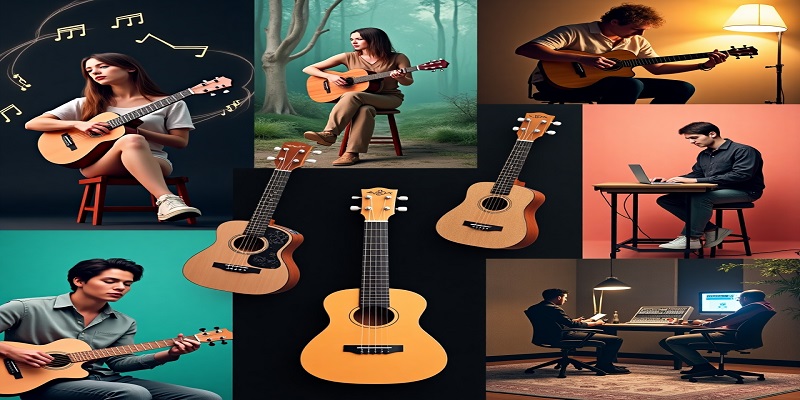
7.1 Pop Stars & the Ukulele: Billie Eilish, Taylor Swift and More
The ukulele has evolved from a novelty to a respected instrument that can be used to invoke intimacy, nostalgia, and innovative production in the digital age.
‘Billie Bossa Nova’ by Billy Eilish (2021) Check out the review. The Grammy winner demonstrated the ukulele’s place in today’s alternative pop by incorporating it into this seductive jazz-influenced song from Happier Than Ever.
Folklore & Evermore by Taylor Swift (2020–2021)
Swift’s indie-folk shift emphasized the ukulele in lyrical ballads and minimalist recordings, increasing its usage in poignant, narrative compositions.
More recent instances
Ed Sheeran used it in his early songs, such as “Lego House.”
Initially, Olivia Rodrigo used ukulele chords in her widely shared “Drivers License” sample.
K-pop artists have performed acoustic versions of it like DAY6 and BTS.
This tendency reflects a larger change: the ukulele is now the studio Swiss army knife for musicians who wish to utilize its warmth and simplicity. It is no longer just for campfire celebrations.
7.2 Custom & High-End
The tip of the spear is bespoke luxuries.
- Manufacturers like Mike Pereira (California) and David “Pops” Koenig (Hawaii), to mention a couple, hand-build custom ukuleles with exotic woods (koa, mahogany) and intricate bracing for deeper resonance. • Brands like Kamaka and Kanile’a, which were once niche, are now sought after by collectors and touring musicians.
The Reasons Experts Invest
Studio Quality Sound: High-quality ukulele instruments sound better than inexpensive plastic and wood ones, allowing you to record and play.
Crossbreed Innovations: Electric-acoustic ukuleles, like the Risa LP type uke, represent a hybrid of modern and classic styles.
Sustainability: Artists who care about the environment favor products manufactured with ethical materials, such as Blackbird, whose ukuleles are made of carbon fiber.
The boutique growth in the guitar industry is a reflection of this tendency, which is more proof that the ukulele has emerged as a legitimate instrument at the highest musical levels.
8. Types of Ukuleles: An In-Depth Look
Beyond its white, figure-eight-shaped Hawaiian roots, the ukulele family has grown to include a wide range of sizes, tones, and styles for all skill levels, from electric experimental hybrids to deep-voiced basses and nostalgic sopranos. Here are some tips for navigating the vast world of contemporary ukuleles.

8.1 Soprano, Concert, Tenor, Baritone: Which one is right for you?
The 4 Major Uke Sizes vary in scale length, tuning, and sound, appealing to different styles of playing and player preferences.
| Type | Size (Scale Length) | Tuning | Sound Profile | Famous Players & Uses |
| Soprano | 13–14″ (smallest) | G-C-E-A (high re-entrant or linear) | Bright, jangly, classic “uke” tone | Tiny Tim (“Tiptoe Through the Tulips”), vintage Hawaiian music |
| Concert | 15–16″ | G-C-E-A (often re-entrant) | Warmer than soprano, fuller midrange | Jake Shimabukuro (early stuff), Israel Kamakawiwoʻole |
| Tenor | 17–19″ | G-C-E-A (or low-G for depth) | Rich, low, still closer to a small guitar | Jake Shimabukuro (contemporary), James Hill, colleges-educated performers |
| Baritone | 19–21″ (largest) | D-G-B-E (Similar to top 4 strings of a Guitar) | Deep, mellow, guitar-like | Eddie Vedder (“Ukulele Songs”), folk and jazzers |
Choosing Your Fit:
- Beginners: Standard figure (more compact, less expensive) or Concert (easier to fret.)
- Performers: Tenor (active if you need fingerstyle, more presence/pop in chord work).
- Guitarists: Baritone (same tuning, no changeover).
8.2 The Weird Stuff: Bass Uke, Banjolele, and Electric Ukes
Today, luthiers (those who make and repair stringed instruments) as well as musicians have reinvented the ukulele by turning it into a custom-tuned instrument for genres from funk to rock.
| Variation | Description | Tuning | Why It’s Unique | Famous Users |
| Bass Ukulele | Extra fat rubber bands, like ~20 inch scale (where they’re shorter, about the size of one of your hands). | E-A-D-G (like a bass guitar) | Punchy, low-end thump—ideal for bands. | Kala UBass (you’ll see this with indie/folk guys) |
| Banjolele | Banjo body + ukulele neck | G-C-E-A | Twangy, loud, perfect for ragtime/bluegrass. | George Formby (stellplatten clip on artists/british music hall legend) |
| Electric Ukulele | Solid-body or acoustic-electric | G-C-E-A or custom | Effect (delay/distortion) friendly work for rock/jazz. | Taimane Gardner (experimental fusion) |
| Resonator Ukulele | Metal body for slide playing | G-C-E-A or open tunings | Bluesy, metallic growl. | Del Rey (blues/roots music) |
Why They Matter:
- Bass ukes enable ukulele players to ground bands when a full-sized bass won’t fit.
- Banjoleles lend folk and Americana a touch of old-timey.
- Electric ukes fill the space between traditional and modern, ideal for looping or effects-heavy styles.
9. The Ukulele for Education & Therapy
The ukulele is not only a fun instrument — it’s also a valuable resource for learning and healing. Classroom to therapy, its readibility/handle featured design is perfect for all educational and wellness environments.

9.1 Why Do Schools Teach the Uke Instead of the Guitar
For good reason, the ukulele has supplanted more conventional favorites like the guitar and recorder as the preferred instrument in many music education programs and institutions.
Principal Benefits:
A simpler curve for learning
o Fewer Strings: Playing a guitar with four strings instead of six makes chords simpler and reduces the likelihood of frustration.
o Softer Strings: Young musicians can play with ease on nylon strings.
Features include being smaller, lighter, and more portable, making it ideal for little hands.
✔ Improved Engagement = Quicker Progress
In just a few weeks, students can perform entire songs like “Hey Soul Sister” by Train and “Riptide” by Vance Joy, which boosts their confidence.
o Beginners will find strumming patterns less frustrating than fingerpicking patterns on the guitar.
Demonstrated Achievement in Education
A program called “Ukulele in the Classroom,” which started in Canada, has instructed over 500,000 pupils and is still growing.
o To promote group music-making, the Japanese educational system implemented mass ukulele lessons.
In order to preserve heritage, it is taught in Hawaii’s public schools as a component of cultural education.
Real-World Impact: o In the UK, students who learned to play the ukulele demonstrated increased collaboration and attendance.
Because ukuleles are less expensive than guitars and just as versatile, they are taught in American schools with less funding.
9.2 Music Therapy & the Healing Power of the Ukulele
Because of its emotional, mental, and physical benefits, the ukulele is becoming popular in music therapy in addition to schooling.
Therapeutic Advantages:
🧠 Stress Reduction & Mental Health
Group strumming sessions increase the bonding hormone oxytocin and decrease cortisol, which is the hormone released when we are under stress.
· Used in assisted living facilities to combat loneliness and anxiety brought on by dementia.
✋ Rehabilitation & Motor Skills
· For people with Parkinson’s illness or stroke survivors, strumming improves fine motor abilities.
o For children with particular disabilities, chore adjustments promote hand-eye coordination.
💛 Expression of Emotions and Social
o When they are unable to speak, non-verbal patients (such as those with autism or trauma survivors) frequently play.
o Ukulele groups provide a sense of rhythm and peer support for veterans with PTSD.
Examples of Cases:
o MD Anderson Cancer Center’s “Ukulele Therapy” for Cancer Patients: Lessens treatment-related anxiety.
o “Strummerville” (UK): A program that uses the ukulele to help young people at risk develop resilience.
10. The Ukulele of the Future: Trends & Predictions
The ukulele has also defied predictions in the past, rising from near obscurity in the 1980s to a renaissance in the 21st century. What comes next, though? According to trends, it’s not only here to stay but is generally taking on new forms.

10.1 Will the Ukulele Remain Popular?
(And There’s Good Reason to Believe That) Present Trends Suggest Yes — And Here’s Why:
📈 Sales & Market Growth According to industry reports for 2023, sales of ukuleles are surpassing those of the majority of other acoustic instruments, especially for novices.
o Despite being merely a “toy,” companies like Kala and Flight report double-digit growth in their mid-range and premium devices year over year.
🌍 Boom in Online Engagement
o With millions of posts, TikTok and Instagram reels are the driving force behind phenomena like #UkuleleChallenge.
o YouTube tutorials are used to onboard new players (The Ukulele Teacher, Cynthia Lin).
🎸 The Upcoming Virtuoso Generation
o Pop is kept up to date by young musicians like Tate McRae, who began playing the ukulele, and Grace VanderWaal, who competed on America’s Got Talent.
o Game changers in jazz and fusion, like Kris Fuchigami, inspire intermediate and advanced players with their stretching skills and rhythm.
Based on its cultural appeal and adaptability, it is predicted that the ukulele will become a popular “entry” instrument, similar to the recorder, but with long-lasting appeal.
10.2 The Changing Face of the Ukulele from ukulele history
Technology is altering how we play and even what a ukulele can be, thanks to AI learning and innovative technology.
🔊 Smart Ukuleles or The Populele 2 (LED fretboard lighting for novices) and Enya Nova U (carbon fiber, built-in effects) combine technology and tradition.
o To create experimental sounds, hybrid electric ukes (like Risa’s LP style) are played via guitar pedals.
Apps and Online Education
o Yousician and Fender Play provide you instant feedback on your strumming accuracy.
An AI-powered platform called Tunefox allows users to customize ukulele arrangements of popular songs. 🎛 The “Digital Ukulele Community” was born.
o International players are connected through online communities like Ukulele Underground and Ukulele Corner.
Musicians from other nations can collaborate through virtual jam sessions on Zoom or Soundtrap.
Prediction: Self-tuning ukuleles and AR-led training will become commonplace during the next ten years, further dismantling obstacles.
Final Note: A Tool for the Future
The ukulele’s future lies in innovation rather than merely survival. The ukulele is poised to become a symbol of happiness, accessibility, and inventiveness for future generations as technology facilitates education and musicians keep expanding the instrument’s potential. Its essence endures whether it is acoustic or digital, basic or opulent: tiny instrument, limitless potential.
Want to Explore Further in ukulele history?
o Travel across time: Watch the 2010 documentary “The Mighty Uke.”
o Play timeless songs: Look up a lesson for Jake Shimabukuro’s “While My Guitar Gently Weeps” or “Over the Rainbow.”
o Get involved: Look for online communities like Ukulele Underground or local ukulele jams.
The ukulele history serves as a reminder that wonderful music doesn’t have to be complicated. So pick one out, tune up your strings, and join in on its classic tune. After all, you might be the one to write the next chapter.
What are a concert, tenor, baritone, and soprano ukulele?
A: Size, pitch, and tone are the only variations:
FAQs of Ukulele History
What is a soprano, concert, tenor, and baritone ukulele?
The only difference is size, tuning, and tone:
Soprano (13-14″): Smallest, brightest tone, traditional “uke” sound (Tiny Tim).
Concert (15-16″): larger, warmer sound, more space between the fingers (Israel Kamakawiwoʻole) • Tenor (17-18″): larger, warmer sound, even more space between the fingers.
Tenor (17-19”): Lower, more mellow, common for fingerstyle (Jake Shimabukuro).
Baritone (19-21’’): The biggest one, tuned on a nuclear quart of a guitar (Eddie Vedder).
Can you learn a ukulele more easily than a guitar?
Indeed! Most beginners can be playing songs in a matter of weeks because to the guitar’s compact body, simpler chords, and only four nylon strings (as opposed to six steel strings).
What is meant by “re-entrant tuning”?
When the strings are not arranged in ascending sequence, that occurs. The high-G tuning, which is the most popular for the ukulele (G-C-E-A), gives it a distinctive jangly sound since the G is higher in pitch than the C.
The ukulele was made famous by whom?
Proponents of it in the late 19th century include King Kalākaua, Hawaii’s own “Merrie Monarch.”
Cliff “Ukulele Ike” Edwards, a legendary figure in jazz from the early 1920s.
Israel Kamakawiwoʻole, who once again sent it skyrocketing with “Over the Rainbow” in the 1990s.
The contemporary virtuoso Jake Shimabukuro.
Are you able to play jazz or rock ukulele?
Of course! Rock musician Taimane Gardner and jazz musician Lyle Ritz are examples of the ukulele’s flexibility. Its reach is further increased with electric ukes and effects pedals.
Why is the ukulele taught in schools instead than the guitar?
It’s easier for younger students, more smaller, and less expensive. Little fingers can play nylon strings more easily, and simple chords help kids play more quickly.
Do pricey ukuleles make sense?
A ukulele that costs between $50 and $100 is more than sufficient for amateur players. However, premium versions (such as Kamaka and Kanile’a) have a deeper tone, sustain, and craftsmanship, making them ideal for performers.
Will people continue to play the ukulele?
According to trends, absolutely! The instrument’s future is guaranteed by smart ukuleles (like Populele), popular TikTok covers, and usage by musicians like Taylor Swift and Billie Eilish.

